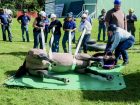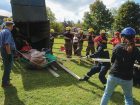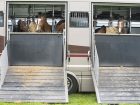
Features
Training
Livestock lessons
Firefighters sometimes deal with emergencies involving unpredictable and possibly dangerous participants. This is especially true for members of rural departments who are more likely than their urban counterparts to respond to calls involving farm animals. These incidents can test both the skills and the wit of even veteran firefighters.
February 4, 2015
By Barbara Sheridan
Victor MacPherson, a district chief with the Adjala-Tosorontio Fire Department in Loretto, Ont., once responded to an incident involving a pick-up truck transporting eight sheep.
“The driver succumbed to a heart attack, and the truck went off road into a ditch,” MacPherson said in an interview. “Ambulance and firefighters arrived, and both the driver and occupant were transported to the hospital.”
Attention then turned to the animals. The surviving sheep were quickly rounded up, MacPherson said, but the situation could easily have evolved into a mad scramble to keep both animals and people out of harm’s way.
“We were fortunate that the sheep were well handled and compliant,” he said. “If it was a larger group of animals, such as cattle or horses that were stressed and panicking, then it could have been a different outcome.”
Techniques and equipment for these types of rescue have improved in the past 20 years, said Rebecca Gimenez, a specialist in animal physiology who teaches technical large-animal emergency rescue (which is known by the trademarked acronym TLAER), to firefighters across North America.
In the past, Gimenez said, fire departments relied on those among their ranks from rural, agriculture backgrounds, those with livestock-handling experience, or veterinarians close to the scene to provide expertise during animal rescues. Too often, however, first responders would arrive at the scene with only their best judgment. Without proper training and equipment, Gimenez said, many emergency calls resulted in injuries to or deaths of the animal and/or the rescuers.
If emergency responders lack the knowledge to mitigate the incident, Gimenez said, a well-meaning citizen or frantic owner could jump in and attempt to help the animal, transforming the large animal emergency into a human emergency.
After Hurricane Frances in Florida in 2004, and Hurricane Katrina in New Orleans in 2005, it became evident to emergency managers and animal experts that there was a need for increased training in animal rescue. It was through the efforts of John Haven, a director of the College of Veterinary Medicine at the University of Florida, that a new chapter was added to the 2014 edition of NFPA 1670 Standard on Operations and Training for Technical Search and Rescue Incidents. Chapter 17 and Annex K of the new edition outline the basic training methods, equipment and techniques to prepare fire departments to assist in animal technical-rescue efforts.
■ The large-animal challenge
In September, the Adjala-Tosorontio Fire Department hosted a technical large-animal emergency rescue awareness workshop and operations-level course, taught by Gimenez and sponsored by the not-for-profit group Equine Guelph. The 50 participants included firefighters, veterinarians, animal-care and control professionals, law enforcement personnel and horse owners – some from Texas, British Columbia, and Quebec.
MacPherson said the course provided fire department members with information, ideas and strategies for dealing with animal-rescue calls.
“For instance, if there is an animal at large on the road, we now have enough information to know how to properly corral that animal and how to safely move it,” he said.
“If an animal has been involved in an accident, we know what type of resources we are going to need fairly quickly in order to perform a large-animal rescue that is safe for both the rescuers and the animals involved. However, we are also very aware that human life is priority one and the animal’s safety is No. 2.”
Gimenez stressed to the group that when it comes to animals, responders never know what they’ll find when they’re called out; it could be a horse that is trapped in the mud or has fallen through an icy pond, or cattle in an overturned trailer on the highway.
“There is one constant in all large-animal incidents,” Gimenez said, “No matter the size, they are all highly unpredictable.”
Based in Georgia, Gimenez has a PhD in animal physiology and more than 20 years of experience participating in large-animal rescues; she helped to write the Standards for the Animal Rescue Technical portion of NFPA 1670. Her goal, she said, is to provide specific training at the awareness, operations and technical levels.
Large animals and horses are the most difficult to deal with due to their size and difficult manageability, Gimenez said; there are also logistical challenges with rescuing and sheltering them.
“Anecdotes, Facebook pages devoted to this specialty rescue, training efforts going on worldwide, and standards such as NFPA 1670 and 150 show that emergency responders are trying to improve their readiness and professionalism on scene,” she said.
■ Hands-on technique
An informal survey of law and fire-service personnel conducted by Gimenez’s training company, TLAER Inc., in the United States in 1999 revealed that only about five per cent of first responders were familiar with the handling of large animals, and even fewer felt comfortable handling them. This indicated a direct need in more training to safely rescue large animals, Gimenez said.
“Often emergency responders will wait for the vet to arrive, and then turn to him or her for guidance,” she said. “However, veterinarians may not have the necessary large-animal rescue training or be unsure of the correct incident-safety procedures. Rarely will they have any PPE [personal protective equipment]. And what shall [responders] do if the vet is over two hours away?”
Safety is the most important rule when dealing with large animals, Gimenez said. In a rescue situation, large animals are more likely to behave frantically or aggressively when they are stressed. As a result, the most difficult skill for rescuers to learn is animal handling. Rescuers are taught to remain out of the animal’s “hot zone” through distance and shielding. Good, quality PPE – helmets, gloves and boots – should all be worn when working with large animals.
“When trapped, the biomechanical force used when running is instead transferred to attempts to rise or extricate itself,” Gimenez said. “Always call a vet to the scene immediately, that way the animal can be sedated if there’s any doubt about its temperament. Then keep the environmental stimuli to a minimum.”
Strive for a simple rescue by stepping back and conducting incident planning for a safe result. Follow that up with an appropriate work plan, including what to do with the animal afterwards. “The best way to keep a horse immobilized after a rescue is to set up a small corral with temporary fencing and then just toss them some alfalfa hay,” Gimenez said. “That’ll keep them happy and content until they can be moved.”
Connect beforehand with vets who specialize in large animals, and, ideally, are familiar with large-animal rescue training, know the on-scene safety incident-command protocols, and have agreed ahead of time to respond, should firefighters require their services.
■ Equipment
Part of large-animal rescue training allows personnel to familiarize themselves with the appropriate equipment and its many purposes so they can be safe when working around animal-rescue incidents.
“The anatomy of terrestrial animals is basically the same, whether it’s a dog or horse or cow,” Gimenez said. “However, attaching ropes to a large animal and trying to pull it out of a tight area by its head, limbs or tail is not a safe rescue.”
Instead, she said, thread webbing around large muscle groups with long-hooked poles; the animal can then be safely dragged out of a flipped trailer, a ditch or mud. Protect the animal’s downside eye with something as simple as a lifejacket (or similarly padded object) and move the animal onto a rescue glide.
While some technical rescue gear can be costly – such as $250 for a Nicopolous Needle to push a pilot line under a horse in the mud, $2,500 for a Rescue Glide sked to move recumbent animals, or $15,000 for a 318-kilogram (700-pound) rescue horse training mannequin – most of the items required are already available on fire trucks.
“While a lot has to do with the proper equipment, for what we now know, we could easily use plywood, tarps, drags, straps, etc.,” MacPherson said. “We have tools to cut an over-turned trailer. We have the heavy equipment available to move a vehicle or trailer. And while we don’t have a rescue glide, give us 30 minutes, we can make one out of webbing and strapping for procedures such as forward assist, sideways drag and backwards drag.”
There are many general items that can be used for animal technical rescue in field situations, Gimenez said, such as 10 metres (33 feet) of webbing that is 10 centimetres (four inches) wide, a boat hook and seven metres (23 feet) of rope to make a rope halter.
“Just remember to always keep in a safe position when using this equipment.”
■ A GOOD OUTCOME FOR ALL
According to Gimenez, large-animal rescue has come a long way with the development of better methods.
In the past, Gimenez said, rescuers used old chemical drums filled with water and dead large animals to practice rescue techniques.
“Then we became confident enough to use live animals to prove that these techniques work. Now we’re provided with plenty of situations via social media and TV news through video and photos, and we use training mannequins to simulate safer and more humane rescues. This in turn creates a more positive outcome for large animals in need of rescue and for the rescuers themselves.”
Guidelines for large-animal rescue
- Don’t underestimate the potential risks involved
- Understand fear behaviour when it comes to approach, capture, containment, restraint, and handling
- Understand basic anatomy when applying rescue techniques such as drags, lifts and assists
- Increase contact with the animal’s body surface area for safer extraction
- Employ arm extensions for reaching through the use of hooks, poles, etc.
- Follow proper incident command and company operation protocol.
- Always recommend to owners that their animals be seen by a veterinarian immediately after the rescue
Rebecca Gimenez’s book, Technical Large Animal Emergency Rescue, is available through the Firehall Book Store. For more information on large-animal rescue, visit www.tlaer.org
Barbara Sheridan is a freelance journalist based in Ancaster, Ont. Email her at bjs@cavaliercreates.com
Print this page


